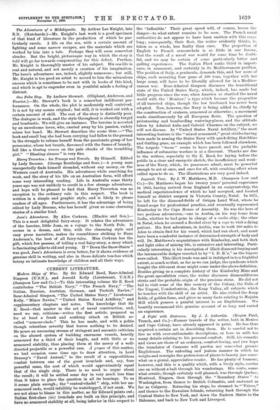CURRENT LITERAT U RE.
liod,ern Ships of War. By Sir Edward Reed, Rear-Admiral Simpson (U.S.N.), and Jerrold Kelly (Lieutenant, U.S.N.) (Sampson Low and Co.)—To this interesting volume Sir E. Reed contributes "The British Navy," "The French Navy," "The Italian, Russian, Austrian, German, and Turkish Navies ;" Rear-Admiral Simpson, "The United States Navy;" Lieutenant Kelly, "Minor Navies," "United States Naval Artillery," and supplementary chapters and notes. The knowledge that Sir E. Reed—that master in the art of naval construction, and, need we say, criticism—writes the first article, prepared us for at least a frank and scathing attack on British so- called "armour-dads." This he has made, and with a polite though relentless severity that leaves nothing to be desired. He pours an unceasing stream of stringent and sarcastic criticism on the absurd system of building enormous vessels, heavily armoured for a third of their length, and with little or no armoured stability, thus placing them at the mercy of a well- directed projectile or a powerful ram. A propos of this matter, we had occasion some time ago to draw attention, in Lord Brassey's "Naval Annual," to the result of a supposititious combat between one of the great ironclads and, say, four powerful rams, the cost of which would approximately equal that of the single ship. There is no need to argue about the result; it will be settled some day in very much less time than it takes to place the question in all its bearings. To us it seems plain enough ; the "central-citadel" ship, with her un- armoured ends, would infallibly be waterlogged, if not sunk. We are not alone to blame in this matter, as Sir Edward points out; Italian first-class (sic) ironclads are built on this principle, and have no armoured stability at all, being inferior in this respect to the 'Inflexible.' Their great speed will, of course, lessen the danger—to what extent remains to be seen. The French naval authorities do not appear to have been smitten with this craze long ; consequently, their fleet, the writer evidently thinks, is, taken as a whole, less faulty than ours. The proportion of English to French armourclads is so little in our favour, that the result of a naval war would for some time be doubt- ful, and we may be certain of some particularly bitter and galling experiences. The Italian Fleet ranks third in import- ance, in armament, and certainly in its Mediterranean position. The position of Italy, a peninsula, demands this, and her score of ships, each mounting four guns of 100 tons, together with her large army, will have to be liberally allowed for in a Mediter- ranean war. Rear-Admiral Simpson discusses the transitional state of the United States Navy, which, indeed, has made but little progress since the war, when America so startled the naval world with the Monitor,' .a type which became the progenitor of all turreted ships, though the low freeboard has never been adopted. Now, however, the Navy is being added to, chiefly by the construction of cruisers, armoured or otherwise ; a movement made simultaneously by all European fleets. The question of privateering and bombarding watering-places, and the attitude taken by Admiral Aube and Gabriel Charmes on the subject, we will not discuss. In "United States Naval Artillery," the most interesting feature is the "mixed armament," great strides having been made in arming the States Navy with quick-firing Hotchkiss and Gatling guns, an example which has been followed elsewhere. The torpedo " boom " seems to have passed, and the probable influence of submarine warfare is at a discount. Thanks are due to the writers, especially to Sir E. Reed, for laying before the public in a clear and energetic sketch, the insufficiency and weak- ness of the Navy, which, its possessors admit, must be powerful enough to act at once, and once for all, with crushing effect when called upon to do so. The illustrations are very good indeed.


















































 Previous page
Previous page